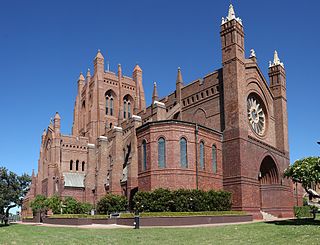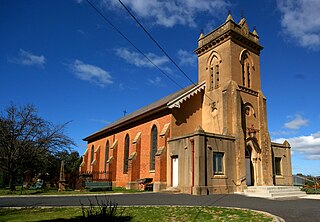
Carlingford is a suburb of Sydney, in the state of New South Wales, Australia. Carlingford is 22 kilometres north-west of the Sydney central business district in the local government area of City of Parramatta. Carlingford sits at the meeting point of Northern Sydney and Western Sydney sitting on both sides of Pennant Hills Road which generally acts as a divider of the two regions. While being part of City of Parramatta, it is sometimes referred to as being part of the Hills District.

Emu Plains is a suburb of Sydney in the state of New South Wales, Australia. It is 58 kilometres west of the Sydney central business district, in the local government area of the City of Penrith and is part of the Greater Western Sydney region.

All Souls is an Anglican church in the Diocese of Sydney. The church is located in the corner of Norton and Marion Streets, Leichhardt, New South Wales, Australia.

The Cathedral Church of Christ the King, also called Christ Church Cathedral, is an Anglican cathedral in Newcastle, New South Wales. It is the cathedral church of the Diocese of Newcastle in the Anglican Church of Australia. The building, designed by John Horbury Hunt in the Gothic Revival style, is located on a hill at the city's eastern end in the suburb called The Hill. It was added to the New South Wales State Heritage Register on 28 June 2011.

St John's Cathedral is a heritage-listed, Anglican cathedral in Parramatta, City of Parramatta, Sydney, New South Wales, Australia. St John's was given the status of provisional cathedral of the Anglican Diocese of Sydney in 1969, and designated a Regional Cathedral in 2011 for the Western Region. It was added to the New South Wales State Heritage Register on 5 March 2010.

The St Jude's Church is an active Anglican church in Randwick, a suburb of Sydney, New South Wales, Australia. It is part of a significant heritage group that includes the church, cemetery, rectory and original Randwick Borough Chambers, later converted to church use. The group is located on Avoca Street, Randwick, and has a federal heritage listing. It was added to the New South Wales State Heritage Register on 2 April 1999.

St Peter's Anglican Church is a heritage-listed Anglican church located at 187-209 Princes Highway, St Peters, in Sydney, New South Wales, Australia. It is one of the oldest churches in Sydney. Designed by Thomas Bird, the church is sometimes referred to as St Peter's Church, Cooks River, as it is located in the Anglican Parish of Cooks River, New South Wales. The church is listed on the NSW State Heritage Register and on the Register of the National Estate.

The Garrison Church is a heritage-listed active Anglican church building located at Argyle Street in the inner city Sydney on the edge of the suburb of Millers Point in the City of Sydney local government area of New South Wales, Australia. It was designed by Henry Ginn, Edmund Blacket and built from 1840 to 1846 by Edward Flood and George Patton. It is also known as Holy Trinity Anglican Church and Hall. The property is owned by Anglican Church Property Trust and was added to the New South Wales State Heritage Register on 2 April 1999.

St Michael's Cathedral is a heritage-listed Anglican cathedral at Church Street, Wollongong, City of Wollongong, New South Wales, Australia. It is the principal Anglican church in the city of Wollongong and the mother-church of the Bishop of Wollongong. It was designed by Edmund Blacket and built from 1858 to 1859. The property is owned by the Anglican Church Property Trust. It was added to the New South Wales State Heritage Register on 2 April 1999.

St Thomas' Anglican Church is a heritage-listed Anglican church located in the western Sydney suburb of Mulgoa in the City of Penrith local government area of New South Wales, Australia. The church forms part of the Diocese of Sydney. It was designed by Reverend Thomas Makinson, first incumbent priest and James Chadley and built from 1836 to 1838 by James Atkinson and William Chisholm. It is also known as St. Thomas Anglican Church and St Thomas Church of England. The property is owned by Anglican Church Property Trust. It was added to the New South Wales State Heritage Register on 2 April 1999.

St Mark's Church is an active Anglican church in Darling Point, a suburb of Sydney, New South Wales, Australia. It is part of a significant local heritage group that includes the church, rectory, and adjacent cottage. The group forms part of a large collection of important to late 19th century buildings of considerable townscape, historic and cultural significance, including the former St Mark's Crescent School, St Mark's Cottage and Bishopscourt, formerly Greenoaks.

Holy Trinity Anglican Church is a heritage-listed Anglican church precinct, containing the church, rectory and adjacent cemetery, at 71-85 Gilmour Street, Kelso, Bathurst Region, New South Wales, Australia. The church was built from 1833 to 1878, with John Foster being responsible for the building of the original church. Edmund Blacket designed the rectory. The property is owned by Anglican Property Trust Diocese of Bathurst and Parish of Kelso, Anglican Diocese of Bathurst. It was added to the New South Wales State Heritage Register on 14 January 2011.

St Bartholomew's Anglican Church and Cemetery is a heritage-listed former Anglican church and cemetery at Ponds Road, Prospect, City of Blacktown, New South Wales, Australia. It was designed by Henry Robertson and built from 1838 to 1840 by James Atkinson. It was added to the New South Wales State Heritage Register on 2 April 1999. Since 1975, the site has been leased to the Council of the City of Blacktown.

St Paul's Anglican Church is a heritage-listed Anglican former church building located at 221 Old Northern Road, Castle Hill, The Hills Shire, New South Wales, Australia. It is also known as St Paul's Anglican Church (former) and St Paul's Church (former). The former church was added to the New South Wales State Heritage Register on 2 April 1999.

St Mary's Anglican Church is a heritage-listed Anglican church and associated facilities located at 240 Birrell Street, Waverley, in the Waverley Municipality, Sydney, New South Wales, Australia. The church was designed by Edmund Blacket and built between 1863 and 1864. It is very well known and sought after as a place to be married and is popular for funerals. The building is also notable due its pipe organ, designed and built by August Gern. The property is used for ministry by the Anglican Parish of Bondi and Waverley, which is an amalgamation of two previous Parishes ; The first Rector of St Mary’s Waverley, Rev Stanley Mitchell, was a keen Evangelical and although he used traditional Anglican liturgy was “low church” like most of Sydney Diocese. However there has been a long history of more “High” Anglicanism and Anglo Catholic theological underpinnings. Since 2014, the church has returned to a strongly evangelical base while running a very strong traditional 1662 prayer book communion service every Sunday. It also has less traditional al services to accommodate more contemporary congregations.

St Stephen's Anglican Church is a heritage-listed Anglican church and cemetery at 187–189 Church Street, Newtown, Inner West Council, Sydney New South Wales, Australia. It was designed by Edmund Blacket and built from 1871 to 1874 by George Dowling and Robert Kirkham. The church is also known as St Stephen's Church Of England. It was added to the New South Wales State Heritage Register on 2 April 1999.

St Paul's Anglican Church and Pipe Organ is a heritage-listed Anglican church building and pipe organ located at 205 Burwood Road in the Sydney suburb of Burwood in the Municipality of Burwood local government area of New South Wales, Australia. The church was designed by Edmund Blacket and the organ was designed by William Davidson, with some consultation from Montague Younger. The church and organ were built from 1889 to 1891. The church is also known as St. Paul's Anglican Church and Pipe Organ, St Paul's Anglican Church and Davidson Pipe Organ. The property is owned by Anglican Church Property Trust. It was added to the New South Wales State Heritage Register on 2 April 1999.

St Matthew's Anglican Church is a heritage-listed Anglican church building located at Moses Street, Windsor, City of Hawkesbury, New South Wales, Australia. It was designed by Francis Greenway and built from 1817 by convict labour. The property is owned by the Anglican Church Property Trust. It was added to the New South Wales State Heritage Register on 2 April 1999.

St Peter's Anglican Church is a heritage-listed Anglican church and associated Sunday school, rectory, and cemetery at 384 Windsor Street, Richmond, City of Hawkesbury, New South Wales, Australia. It was designed by Francis Clarke and Edmund Blacket and built from 1836 to 1841 by James Atkinson (church). It is also known as St Peter's Anglican Church Group, St Peter's Church Group, Church, Rectory, Church Yard, Cemetery and Stables. It was added to the New South Wales State Heritage Register on 16 August 2019; and on the City of Hawkesbury local government heritage register, and listed on the New South Wales Heritage Database on 12 September 2012.

St Johns Anglican Church Precinct, also known as St John's Camden, is a heritage-listed Anglican church and associated precinct at 6-22 Menangle Road, Camden, Camden Council, New South Wales, Australia. The precinct comprises the church, rectory, cemetery, two church halls and grounds that provide a rural landscaped environment to the group. The dominant feature of the precinct is the historic St John's the Evangelist Anglican Church. Its architects are unknown, and could be the cumulative work of Mortimer Lewis, John Cunningham and Edmund Blacket. It was built from 1840 to 1849 with Richard Basden responsible for the nave and John Le Fevre adding the spire. 1874 saw the addition of the chancel and vestry, their builder is unknown and the design is likely the work of Sir George Gilbert Scott and Blacket. A feature of the church is an organ manufactured by J. Bates & Son, London. The Anglican Church Property Trust of the Diocese of Sydney holds the property in trust, under the Anglican Church of Australia Trust Property Act 1917 (NSW). The precinct was added to the New South Wales State Heritage Register on 24 August 2018.






















